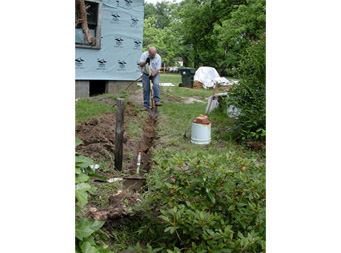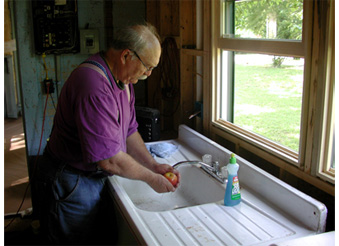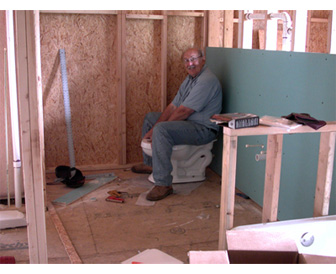
When we purchased the house we found the water shutoff was installed in an area that would be covered by our new foundation. We asked the city to relocate the meter to the property line. In short order Doc's crew located the water line, dug down with shovels to figure out what direction it was heading, used the backhoe to make a hole for the new meter, cut the pipe without turning off the water, slip on a valve and installed the new meter and tap. While they had the backhoe on site, they also figured out where the old sewer stub was at the street.
|

Jim hand-digs a trench from the meter to the house in which will be placed the water supply line. In Georgia, CPVC pipe is used instead of copper for this purpose due to corrosive effects of natural water. Fortunately for him, since the frost line is not very deep, the trench doesn't have to be too deep either.
|

Hacking through tree roots and well packed clay with a mattock. Below we use the truck to remove a piece of iron pipe that previously supplied water to the house.
|

|

Local building codes required that sewer line cleanouts be installed both at the house and at the street. Jim looks for proper fittings to make the connection just outside the house.
|

Above and below both Jim and Elizabeth are seen installing rough plumbing. Elizabeth works on the trench for the sewer line from the washer and bathtub having the approved slope of 1/4-inch per foot. Jim connects the bathroom sink, shower, tub and toilet to the main 4-inch sewer line. Most of the branch lines used 2-inch schedule 40 PVC.
|
 |

We can finally wash our hands (and apples) inside instead of outside with a garden hose. The temporary sink was donated to us by neighbor Steve who was cleaning out one of his projects. We actually began to like the sink with it's built in drainboards very much-it's a good design.
|

After the sewer line was hooked up, we could finally install the best reason for indoor plumbing. Jim was an old pro at installing a Kohler Portrait toilet. He had used them in his previous three homes. Elizabeth drove a nail in the wall as our toilet paper hanger, an easily removed modification when it came time to hang insulation and sheetrock.
Below is the second of three locations we placed the water heater. We liked it here but the inspector thought it was a bit too close to the power panel. The water heater ended up moving about 5 feet to the north in a smaller area and this became a much needed storage area.
|
|
|
|
|